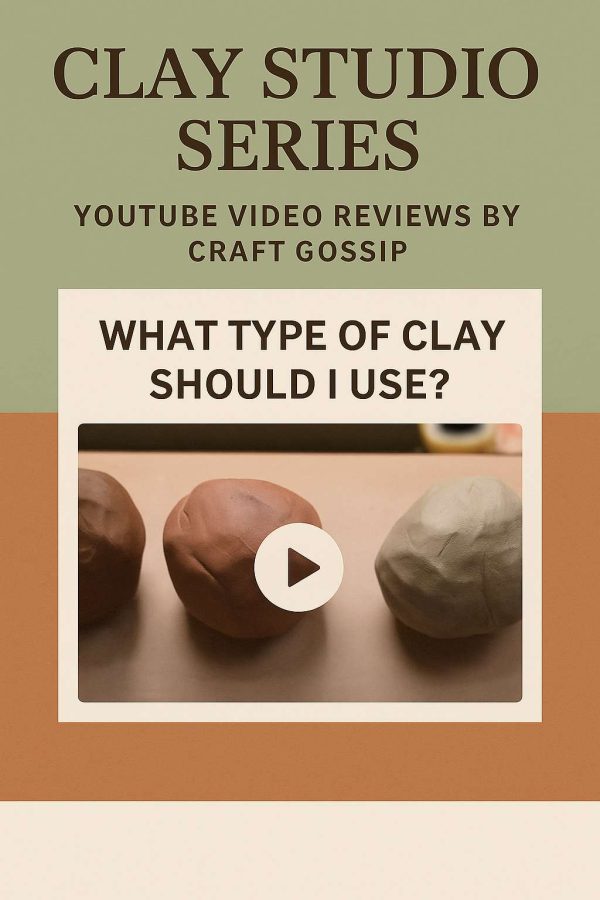 Project Polymer is a new place for clay enthusiast to meet up online. You can win $25 from one of their sponsors for helping get the word out! Visit the forum here for details.
Project Polymer is a new place for clay enthusiast to meet up online. You can win $25 from one of their sponsors for helping get the word out! Visit the forum here for details.
[tags]polymer clay, forums, creativity, crafts[/tags]
Fimo and clay tips and tutorials
 Project Polymer is a new place for clay enthusiast to meet up online. You can win $25 from one of their sponsors for helping get the word out! Visit the forum here for details.
Project Polymer is a new place for clay enthusiast to meet up online. You can win $25 from one of their sponsors for helping get the word out! Visit the forum here for details.
[tags]polymer clay, forums, creativity, crafts[/tags]

What Type of Clay Should I Use? Comparing Three Stoneware Bodies
If there’s one question that potters—especially beginners—ask over and over again, it’s this: “What type of clay should I use?” With so many options available, from smooth white bodies to gritty, speckled stonewares, the choice can feel overwhelming. In this Clay Studio Series feature, we’re reviewing a video that takes the guesswork out by throwing, trimming, and comparing three distinct stoneware clays side by side.
Instead of just talking about clay in theory, the potter works directly with three clay bodies and shows the differences in real time. You can see how each clay reacts on the wheel, how it trims when leather-hard, and what kinds of issues may arise depending on the body you choose. This hands-on comparison makes it far easier to understand than simply reading product labels.
The video also tackles a common curiosity: the pink-toned ES80 stoneware, often admired for its warm coloring. The creator points out that this clay is manufactured for reduction firing and won’t give the same results in oxidation, a detail that often gets overlooked by beginners.
For beginners, choosing the right clay can mean the difference between frustration and success. This video demystifies the process by giving a clear visual comparison of three popular stoneware options. By the end, you’ll have a better idea of what qualities to look for in a clay body and which ones might fit your needs best.
For intermediate and advanced potters, the insights are still valuable. Even if you’ve been working with one clay for years, seeing how others handle could inspire you to experiment with something new.
This review proves that clay choice is less about finding a universal “best” and more about learning what works for you. Whether you want smooth, easy-to-handle clay for your first mugs or a robust, grogged body for sculptural pieces, this video is a fantastic guide to help you make a confident decision.
Watch the full video here: What Type of Clay Should I Use?
I’ve recently joined and wanted to introduce myself 🙂
Hey everyone, Knowing how everyone is trying to save money, I found a site that have Polymer Clay blades the Black Surgical ones of Sale at a very low cost. the site is http://www.vulcanstilts.com and I just got mine yesterday. Sharp as all get out!! Hope this helps my fellow polymer clay pals save money.
ok so I wanted to work with my poly clay and use enamel.I cant figure out which type of enamel I need.Any advice? or just where to find what Im looking for:)
Lorena, I know that cold enamels are the ones people use. I’m not sure on the brands but if you can lay hands on a copy of Sue Heaser’s encyclopedia of polymer clay techniques or one of Patricia Kimle’s books there are enamel projects in them.
Probably just googling about those will tell you which ones they used!
I am a beginner at working with polymer clay. So far I love it, however, I am having a difficult time finding a clay conditioning machine that doesn’t have a handle that constantly falls off. If anyone could recommend a good one I would be very grateful.
Thanks so much,
Dawn
Hey Dawn!
Any of the better quality pasta machine handles don’t fall off quite so easily.
What we do with our class ones is tie a short string to the handle and the machine so that when it does fall out it doesn’t go flying to the ground. You have to experiment a bit to find where the string can go without tangling as you use the machine.
Hi Joe here. I just put a small piece adhesive tape about 3-4 times around the cam end (that goes into the machine) and then push the handle in.
It will still come out fairy easily but won’t be so loose. I also do lock the machine to my work table and sort of push towards the machine as you turn the handle. That should keep it in place. A pasta machine is a pasta machine. No need to spend over 15-20 bucks. Welcome to the family. Poly clay really has no limits in it’s ability to become magic.
Hi Joe! It’s always good to see what other folks do with their pasta machines. While I have some “budget” ones in that 15-20 bux US range, I do like the sturdiness of my slightly pricier – say 40-60 range – Italian machines. The gears are more reliable and the handles are machined better so they don’t slip much. Luckily you can often find them at garage sales!